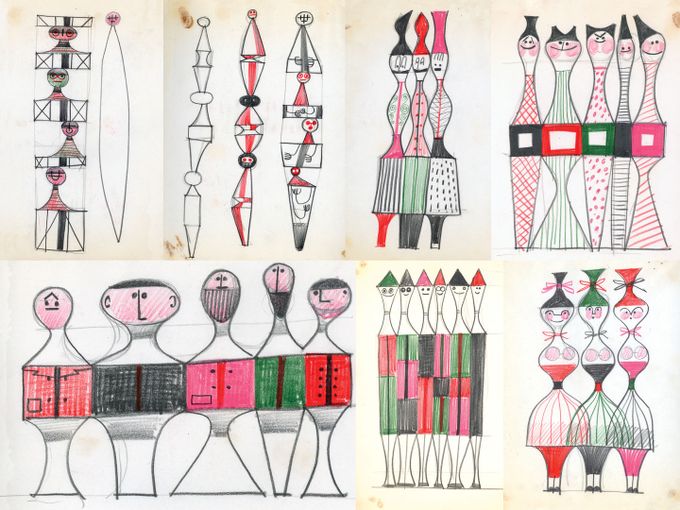ProductsChairsLounge chairsSofasOffice chairsChaises longuesStools & benchesSculpturesConference chairsAirport seatingStorage spaceMicro architectureDining tablesCafé tablesCoffee & side tablesDesksOffice furniture systemsConference systemsLightingClocksDecorative objectsCoat racks & wall shelvesTrays & vesselsNewBestsellerQuickly availableColour & materialAlexander Girard Antonio CitterioBarber OsgerbyCharles & Ray Eames George NelsonHella JongeriusIsamu NoguchiLounge chair finderOffice chair finderGift finderCare & repairSpare partsCare productsManufacturer warrantyVitra Circle StoresLounge Chair & OttomanHang it allInspirationsLiving roomDining roomHome OfficeChildren's roomOutdoorHome StoriesAugmented RealityColours & materialsHome SelectionWorkspaceFocusMeetingWorkshopClub OfficeCitizen OfficeStudio OfficeDynamic SpacesHospitalityAirportsEducationCo-WorkingHealthcareOur ClientsDestination WorkplaceA case for classicsOffice chairsDancing OfficeHome StoriesThe Home Selection fabrics from Kvadrat and DedarAugmented Reality - bring Vitra products into your homeSchool of Design: Showcase work and knowledgeA case for classicsColour & materialAn open house An office landscape - without walls or partitionsHigh comfort of low energyA leading space for a leading art collegeServicesCare & repairSpare partsCare productsManufacturer warrantyFAQ and contactInstructionsConsulting & Planning StudioVitra Circle StoresConsulting & planning in the VitraHausInstructionsOutdoor care instructionsRepair, maintenance, overhaul at the Vitra Circle Store Campus ProfessionalsCAD dataProduct factsheetsCertificatesSustainability reportInstructionsEcology informationpConPlanning examplesColour & Material LibraryCertificates and standardsHome SelectionTo the dealer loginOur ClientsMyntDestination Workplace: Visit our clients and partnersAnagram SofaMikadoTyde 2 on castorsACXDancing OfficeOffice chairsMagazineStoriesConversationsExhibitionsDesignerProject VitraA Capsule in TimeSeeing the forest for the treesRefining a classicMynt is a lifetime achievement to meA desk like a typefaceV-FoamSculptural IconsGames bring people together – just like good officesLet there be light!Social SeatingJust Do It!EVER GREENWhy the Eames La Fonda Chair was designedWhen a Sofa is more than just a Sofa: Anagram100% virgin wool – 100% recyclableAn archive is like a time capsuleVitraHaus Loft - A conversation with Sabine MarcelisA 1000 m2 piece of furnitureFrom a toy to an objectThe Eames Collection at the Vitra Design MuseumAbout the partnership between Eames and VitraVitra CampusExhibitionsGuided tours & workshopsFood and drinkShoppingActivities for familiesArchitectureYour eventConsulting & planning in the VitraHausPlan your visitVitra Campus appCampus EventsNewsVitraHausVitra Design MuseumVitra SchaudepotVitra Circle Store CampusOudolf GartenAbout VitraSustainabilityJobs & CareersDesign processThe Original is by VitraHistory - Project Vitra
Design is a highly political profession
A talk with curator Amelie Klein

After touring the world over the past five years, ‘Hello, Robot: Design between Human and Machine’ – the most successful exhibition in the history of the Vitra Design Museum – is now returning to the place where it all began. Curator Amelie Klein explains why it is worth seeing now more than ever and discusses the political responsibility of designers.
Ms Klein, why are you currently so angry?
Amelie Klein: When I think of robotics, it always makes me angry. Insanely angry! And depressed.At the exhibition opening, you spoke of how the theme of the show made you feel depressed. In the preface to the exhibition catalogue, you wrote about your anger. Could you briefly explain this reaction?
I always say that robotics – and by that, I also mean technology in general – is like a coat of paint that covers everything. It makes our lives much easier in many ways, and most of us still think it all comes for free. But upon closer inspection, we soon realise that none of it is free. Most of the technologies we use incessantly are backed by economic or even governmental interests. We get all agitated when another book comes out about the next form of superintelligence, but we don’t think about the fact that we are all sending our data into the ether every minute – becoming commodities ourselves and increasingly heading towards digital surveillance capitalism.When I think of robotics, the first thing that comes to mind is R2-D2 from Star Wars, which is also a highlight of the exhibition. But now, if I understand you correctly, you're talking more about our smartphones and the apps we use on them. Do I have a false notion of what a robot is?
The first thing most people think of when they hear the word robot is the Terminator, R2-D2, Wall-E – some kind of humanoid machine that either kills us or serves us tea. Our ideas are shaped by popular culture, and that’s exactly where we connect with visitors to the exhibition. But then it quickly becomes clear: robots don’t need a body. The self-scanning supermarket checkout is just as much a robot as a drone, a self-driving car or even our smartphones. Anything can be a robot as long as it has sensors to measure data, software to interpret that data, and actuators to generate a physically measurable reaction, such as a dot of light on the screen.
The core message of the exhibition back in 2017 was already ‘Don’t be afraid of the Terminator, but be extremely wary about the developments in our increasingly smart, increasingly robotic environment’. Can you translate that again into concrete terms: what should we beware of and what should we not be worried about?
What we don’t have to be afraid of in the foreseeable future is the giant machine, the one superintelligent being that will take over the world, develop a consciousness, take away our jobs and end up destroying the human species. We had a problem right at the beginning of this video call when we couldn’t hear each other. Anyone who hasn’t experienced failed technology at least once in the past week, please get in touch! But what we should be afraid of every minute, every second of the day, are the big tech companies from Silicon Valley – also referred to as the Big Five – who control most of our digital lives. These five companies have economic interests and have produced some of the richest people in human history. How do they make these immense profits? We think we are the ones using something. But the truth is that we are being used. As a commodity. Who are we being sold to? To the advertising industry. What makes us so valuable? The data we generate. Every time we pick up the computer or our smartphone, we leave traces.Which traces?
Every page we visit, every ‘like’ that we give makes us predictable. The companies mentioned above know exactly what we do and don’t like. That’s why it’s so much more efficient to sell us as users to online advertisers than to stick a poster on a bus stop or place an ad in a magazine.
And why is that dangerous?
The business model of many sites, especially social media, is to keep users on the screen as long as possible in order to collect maximum data, to be able to assess the person as thoroughly as possible, in order to be able to sell advertising that is as targeted as possible. These pages are designed accordingly: we are supposed to scroll down further, give another ‘like’, check again what the comment is about. These actions trigger the same areas in our brain as seen as with drug use – the phenomenon of ‘immediate gratification’. And as with any drug, we want more of it, in ever more intense forms, which leads to more and more extreme content being served to us. And this in turn leads to something we see in real life: the extreme polarisation of society. We no longer leave our bubbles, we no longer talk to each other. And that, as we all know, is a problem.Sounds quite gloomy and dystopian. Have there been any positive developments in the past five years?
Now that we have understood that algorithms can influence elections and seen what hate speech can lead to, some notable social counterforces have also emerged, yes. Through increased awareness of what is going wrong, we are recognising opportunities as individuals to counteract – for example the ability to influence data transfer and use other platforms. In Austria, a new compulsory subject is being taught in schools – digital literacy. Open-source science databases are on the rise. We realise that technology is a tool and we as a society have to decide how we want to use this tool. This is also highlighted in our exhibition.What responsibility does design have in this?
Design is a highly political profession with an extreme responsibility. It is a bridge that connects two entities that do not seem to belong together. Design is what links us and the steam engine, us and biochemistry, us and technology. It is the central cultural force that makes a large collective body behave one way or another, it acts as a link that provides a translating function, a superpower. If you have a superpower, you have power and with power comes responsibility: what ideas do I make available to people? Can I reconcile it with my conscience to work for a company that captures our data non-stop? That exploits its employees? That gets children addicted to games? Don’t get me wrong, I firmly believe in the power of design – it can also achieve other things, it can bring about astoundingly positive outcomes. But many designers are not aware of their immense responsibility.Can you give me an example?
The smartphone was not dangerous at the beginning. Or the ‘like’ button. It wasn’t about getting everyone addicted. It was about generating more love and affection. Of course, that was extremely naïve.The exhibition is organised according to 14 key questions. To conclude this interview, I’d like to ask you three of them – please answer in one sentence. What was your first experience with robots?
A wind-up toy when I was quite young.
Could a robot do your job?
Can a robot truly be funny? Only if it is very well programmed. And despite all the serious information, there’s a lot of humour in the exhibition, which would be beyond the capability of today’s robots.

Do you want a robot to take care of you?
Robots are already taking care of each and every one of us – my weekly playlist is generated by a robotic system, as is the presentation of content from all the news apps I obsessively check every day or the technological app you and I are currently using to communicate.Have you actually become fond of any of the robots in the exhibition?
I have a soft spot for Wall-E and R2-D2 – they’re two quite unpredictably charming creatures – and that’s exactly why they’re absolutely unrobotic.Publication Date: 24.11.2022
Images: 1: Twentieth Century Fox and Lucasfilm Ltd. R2-D2, 1977. © & TM 2017 Lucasfilm Ltd. ; 2: Ted Hunt, Luke Sturgeon, Hiroki Yokoyama, »Synthetic Temperaments of Drones«, 2014 © Ted Hunt, Luke Sturgeon, Hiroki Yokoyama; 3: Tatsuya Matsui, »Patin«, 2014 © Flower Robotics, Inc; 4: Historic toy robots, 1956 – 1980 private collection, photo: Andreas Sütterlin; 5: Jan De Coster, »Robin«, 2015 © Jan De Coster; 6: Stephan Bogner, Philipp Schmitt and Jonas Voigt, »Raising Robotic Natives«, 2016 © Jonas Voigt
Author: Franziska Klün in conversation with mit Amelie Klein


